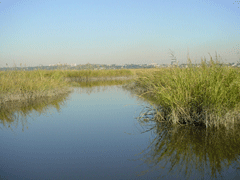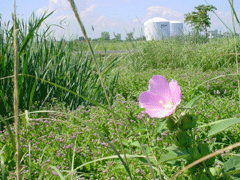Banking on Wetlands
Air Date: Week of November 3, 2006

A bird’s eye view of the New Jersey Meadowlands, alongside the New Jersey Turnpike. (Courtesy of the Louis Berger Group)
Wetlands are disappearing at an astonishing rate across the United States. Private companies have come up with a profitable solution to counter the loss. Living on Earth’s Ashley Ahearn reports on the problems and potential of this booming environmental industry known as "wetland mitigation banking."
Transcript
CURWOOD: OK, it’s time now for a quiz. What feature of the landscape helps with flood control, biological diversity, groundwater replenishment, and water purification?
If you answered wetlands, go to the head of the class. But the United States is now down to half the wetlands it had when the country was founded and thousands more acres of wetlands get paved over or filled in every year.
Living on Earth’s Ashley Ahearn reports on the booming industry of wetlands mitigation banking, its promises and perils.
[CAR/TRUCK BUMPING ALONG HIGHWAY]
AHEARN: Driving south from New York City the New Jersey Turnpike is lined with
power plants, sports arenas and an airport. But tucked in among the industrial complexes is a cement-encircled wetland Eden.

A bird’s eye view of the New Jersey Meadowlands, alongside the New Jersey Turnpike. (Courtesy of the Louis Berger Group)
AHEARN: On a sunny day Virginia Kop Kash, an ecologist with the New Jersey Department of Environmental Protection takes a boat out to inspect a section of the Meadowlands.
[BOAT ENGINE STARTED AND THEN REVVED TO SET SCENE ON WATER]
KOP’KASH: Oh that is so neat. You see it’s flying right there?
AHEARN: Yeah, what is it?
KOP KASH: Uh, an Osprey and it has a fish
AHEARN: That’s it coming around right there.
KOP KASH: Yeah

Egrets and other shorebirds make themselves at home.(Courtesy of the Louis Berger Group)
SAMMANS: This area was used as a sedimentation basin essentially for when they constructed the turnpike so they were pumping in sediments to build the bed for the roadway.
AHEARN: Ed Sammans is an environmental consultant. The Williams Companies bought these wetlands in 1995 and later hired Sammans to restore them. They removed sediment to reopen waterways through the marsh and recreate the original ecosystem. But the company didn’t just do it out of the goodness of its heart. It was a business proposition: Improve wetlands and make money.

The Williams Companies dug channels to re-circulate water and rejuvenate the wetland. (Courtesy of the Louis Berger Group)
AHEARN: Rich Mogensen oversaw the restoration of the Williams wetland. It cost the company six million dollars, and when they were done, they’d created what’s called a wetland bank. Then the company sold credits from their bank for 165,000 dollars a piece, to developers who wanted to build on other wetlands.
MOGENSEN: You’re talking maybe 30 million dollars in revenue on a 6 million dollar investment so that was a real good one. That’s a big winner.
AHEARN: The goal of wetland banking is no net loss of wetlands. So if one company restores some wetlands, it’s ok if another company destroys others, as long as the total acreage of wetlands in a state doesn’t decrease.
But critics say that equation just doesn’t add up; wetlands should never be intentionally destroyed. And while the Williams wetland bank has been termed a success, not all mitigation banks work well.
John Mack is an ecologist with the Ohio Environmental Protection Agency. He noticed that some of the wetland banks in his state weren’t healthy wetlands.
MACK: We were seeing what we thought was problems with some of the banks. They were large areas of open water or just were sort of otherwise what we were looking at as problems or failure.
AHEARN: Wetlands fail for lots of different reasons. Changes in water level, or pollution, can disrupt the intricate balance of salinity and oxygen levels in the water.
Mack says it’s easy to mistake a mud-bottomed pond for an intact wetland ecosystem.

A hibiscus moscheutos, or swamp mallow, stands out before The Williams Companies facilities in the background.(Courtesy of the Louis Berger Group)
AHEARN: The state of Ohio declared some of these banks healthy. But Mack saw things a little differently.
MACK: The failure that we had was, from my perspective, is the lack of good ecologically based performance standards, sort of a quantitative goal that you’re gonna hit, or a target.
AHEARN: So Mack set about raising the regulatory bar. Over the past decade he and his colleagues at the Ohio EPA have been going through healthy wetlands in Ohio with a fine-toothed comb to create what’s called an Index of Biotic Integrity. It’s like an incredibly detailed wetland bingo sheet. You can’t win unless you have all the right chips in place: soil composition, plant species, invertebrates, amphibians, and on up the food chain.
But even if state regulators start using the biotic index to approve mitigation banks, Mack says there just aren’t enough regulators on the local level to make sure the banks are keeping up with the guidelines. Wetland Banker Rich Mogensen agrees.
MOGENSEN: One of the primary problems is the fact that they just don’t have the people to oversee these. They’re too busy issuing permits for Wal-Marts to fill in wetlands and they’re not really focused on proper mitigation techniques.
AHEARN: And as it turns out, wetland bankers don’t often have the scientific background to make up for a lack of specific scientific guidance in state regulation. Rich Mogensen has college degrees in biology and geology, but he says that’s not the norm for many of his colleagues.
MOGENSEN: It’s interesting in that there’s not a whole lot of hardcore science people. They tend to be lawyers, they tend to be utility companies and also timber companies.
AHEARN: The federal guidelines for mitigation banking haven’t been revamped since the first banks were created almost twenty years ago. Palmer Hough is a scientist for the U.S. Environmental Protection Agency’s wetland division. He says the scientific definition of what makes a healthy wetland is now more specific, and the federal guidelines need to be updated.
HOUGH: We thought we knew what we needed to measure in order to answer the question is this a successful wetland restoration project and low and behold as our understanding of these natural systems evolved, we realized wow, we weren’t really asking ourselves the right question ten or 15 years ago.
AHEARN: Hough is working on a new set of wetland management standards the EPA will release in the beginning of 2007. But he says it will still be up to the individual states to define what a healthy wetland looks like in their neck of the woods, and to make sure wetland bankers adhere to that definition.
For Living on Earth, I’m Ashley Ahearn.
Links
Living on Earth wants to hear from you!
Living on Earth
62 Calef Highway, Suite 212
Lee, NH 03861
Telephone: 617-287-4121
E-mail: comments@loe.org
Newsletter [Click here]
Donate to Living on Earth!
Living on Earth is an independent media program and relies entirely on contributions from listeners and institutions supporting public service. Please donate now to preserve an independent environmental voice.
NewsletterLiving on Earth offers a weekly delivery of the show's rundown to your mailbox. Sign up for our newsletter today!
 Sailors For The Sea: Be the change you want to sea.
Sailors For The Sea: Be the change you want to sea.
 The Grantham Foundation for the Protection of the Environment: Committed to protecting and improving the health of the global environment.
The Grantham Foundation for the Protection of the Environment: Committed to protecting and improving the health of the global environment.
 Contribute to Living on Earth and receive, as our gift to you, an archival print of one of Mark Seth Lender's extraordinary wildlife photographs. Follow the link to see Mark's current collection of photographs.
Contribute to Living on Earth and receive, as our gift to you, an archival print of one of Mark Seth Lender's extraordinary wildlife photographs. Follow the link to see Mark's current collection of photographs.
 Buy a signed copy of Mark Seth Lender's book Smeagull the Seagull & support Living on Earth
Buy a signed copy of Mark Seth Lender's book Smeagull the Seagull & support Living on Earth

